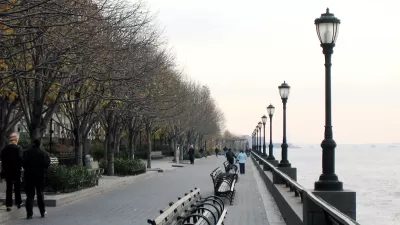New York City Parks Commissioner Adrian Benepe talks with Next American City about the city's increased emphasis on creating active public spaces and how his department is handling budget cuts.
"Next American City: In the earlier years of your tenure you had an increasing budget, which led to what many called a "boom" in park development. How have you dealt with the cuts that have followed the recession?
Adrian Benepe: Our expense budget has gone down. From 2000 to 2006 or so our expense budget more or less doubled, from about $200 million to about $380 million. Our capital budget has been very healthy. Since Bloomberg took office we've spent $3 billion in the capital budget – and we now have a billion and a half in our budget. So we have somewhere around $4.5 billion in capital budget, which had one 30 percent cut. But the budget hasn't really been cut – the tremendous rate of expansion of the budget has slowed. No city is spending what we're spending on parks. Capital dollars are funded through bond issues – so they can't be spent on maintenance, but you can use it to build new parks or rebuild old parks. If you rebuild an old park, chances are it's going to last a long time. We use sturdy materials. For example you can put in new bench slats, the plastic ones that will last forever. The idea that building new parks is antithetical to well-maintained parks is not true – it's the opposite. People tend to treat a good-looking a little bit better."
Benepe also talks about the various partnerships the city has with outside groups to maintain and support its park system.
FULL STORY: An Interview with New York City Parks Commissioner Adrian Benepe

Maui's Vacation Rental Debate Turns Ugly
Verbal attacks, misinformation campaigns and fistfights plague a high-stakes debate to convert thousands of vacation rentals into long-term housing.

Planetizen Federal Action Tracker
A weekly monitor of how Trump’s orders and actions are impacting planners and planning in America.

In Urban Planning, AI Prompting Could be the New Design Thinking
Creativity has long been key to great urban design. What if we see AI as our new creative partner?

King County Supportive Housing Program Offers Hope for Unhoused Residents
The county is taking a ‘Housing First’ approach that prioritizes getting people into housing, then offering wraparound supportive services.

Researchers Use AI to Get Clearer Picture of US Housing
Analysts are using artificial intelligence to supercharge their research by allowing them to comb through data faster. Though these AI tools can be error prone, they save time and housing researchers are optimistic about the future.

Making Shared Micromobility More Inclusive
Cities and shared mobility system operators can do more to include people with disabilities in planning and operations, per a new report.
Urban Design for Planners 1: Software Tools
This six-course series explores essential urban design concepts using open source software and equips planners with the tools they need to participate fully in the urban design process.
Planning for Universal Design
Learn the tools for implementing Universal Design in planning regulations.
planning NEXT
Appalachian Highlands Housing Partners
Mpact (founded as Rail~Volution)
City of Camden Redevelopment Agency
City of Astoria
City of Portland
City of Laramie





























